Written & Photographed by Kenn Sava
This is Part 2 of my look at the work of Richard Estes on his 90th Birthday, May 14, 2022. Part 1 is above, or here. The final Part 3 is below, or here.
Over most of my 35+ years of looking at the work of Richard Estes, I’ve simply enjoyed looking at it, and it certainly lends itself to that. As I’ve already said in Part 1, one result of all that looking is that his Art has come to shape the way I see the world around me. As he turns 90, his Painting career has now spanned more than 55 years1! Recently, I began asking myself “What does it all mean?” This Part looks at what I see.
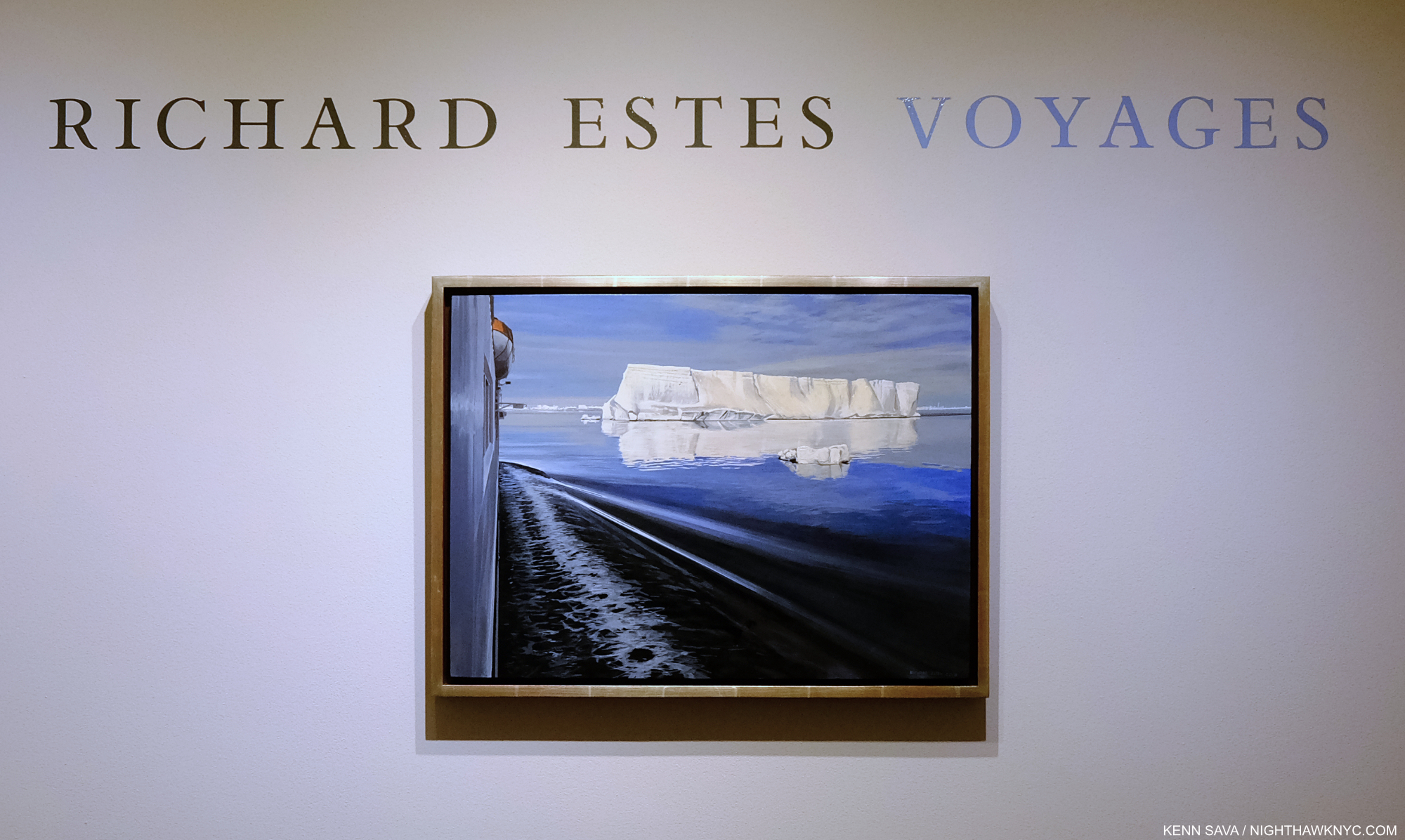
Richard Estes, Antarctica II, 2013, Oil on panel, 16 3/4 x 22 3/4, seen at the show’s entrance. Click for full size.
In Antarctica II from 2013, we see an iceberg floating in a large body of water with a smaller piece of ice, possibly broken off of it, floating on its own. To the left is the hull of the ship apparently containing the Artist on one of his many voyages to a far away land, with the side of a lifeboat visible above. The boat’s wake radiates out towards the berg as the boat moves towards it. One reading of this piece would be man’s impact on Antarctica, which has left it in a precarious state, represented by his alien vessel encroaching on the iceberg’s realm, its wake about to make contact with it.
Not so fast…
“Richard Estes avows that his realism has no hidden meanings, special messages, or stories to tell. Political positions and posturing about the human condition are alien to his art,” in a conversation with Patterson Sims per Patterson Sims, Richard Estes’ Realism2.
Given what I wrote in Part 1 about people disrespecting the Artist’s word on his own Art, though this is not a direct quote (something I address further on), I’m not going back on that now. It is impossible, however, for me not to see the effects of global warming in Antarctica II. How to reconcile this?
Unlike the blockbuster Jasper Johns: Mind/Mirror, which was originally scheduled to coincide with Mr. Johns’s 90th Birthday in 2020, before the virus closed everything, as far as I know at the moment (in early May, 2022), nothing is planned in the Art world to celebrate Richard Estes’s 90th Birthday. My series might be it! Seriously?
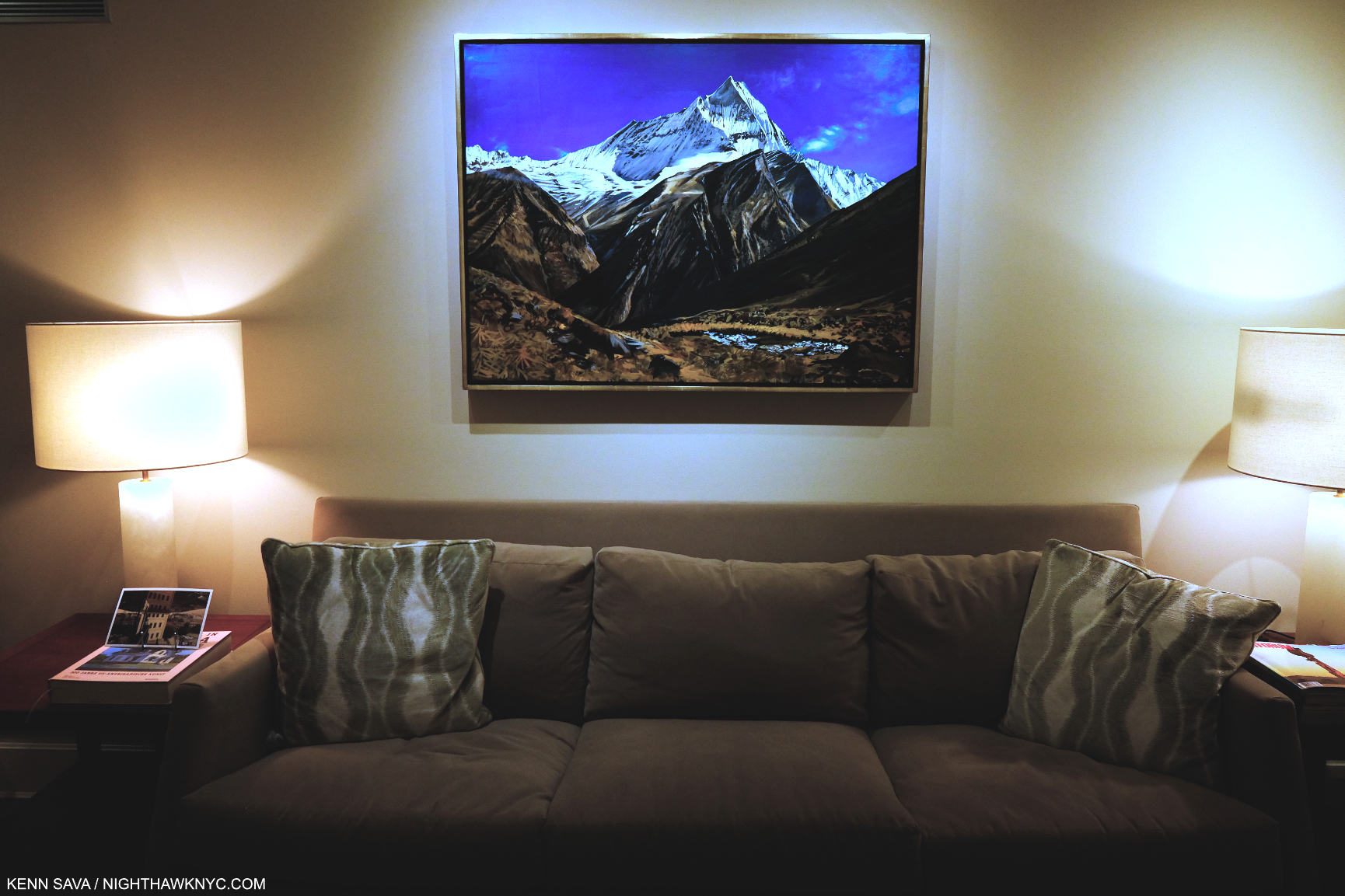
Richard Estes: Voyages installation view of View in Nepal, 2010, Oil on canvas, 32 by 43 inches. Part of the show was very nicely installed in the large office space. In Part 1, I wrote about how I believe this work is conceived. Installed like this makes standing close to it difficult, and so the eye is almost forced to the central, white, peak, causing everything in front of it to be out of focus. It’s really a marvelous and somewhat daring composition for this reason, and a stunning contrast to Richard Estes’s Urban Landscapes, like the one to follow…
The closest NYC Art event that might qualify was Richard Estes: Voyages at Menconi & Schoelkopf in July, 2021, the first show of his work here since the Museum of Art & Design’s Richard Estes: Painting New York City in 2015, which I looked at here. Containing about 30 pieces covering the range of his subjects, Voyages featured more recent work. The theme of the show was ostensibly the annual trips and voyages Mr. Estes has taken over many years and the Paintings that have resulted from them, though these were juxtaposed with some of his iconic NYC Urban Landscapes3. An experienced world traveler at this point, his journeys have taken him to the far corners of the globe. At first, being completely taken by his views of NYC, I didn’t know what to make of the resulting views of forests, bodies of water, mountains and deserts that began emanating from his hand after his travels, first to Maine, then ever further afield. All the while, he still continued to give us his iconic Paintings of New York City, and other cities. When I walked into Voyages and saw the Urban Landscapes alongside African landscapes, Antarctic vistas, and deserts, I finally decided to sit down and do a reconciliation of his entire career and try and finally understand what, if anything, his whole body of work is saying to me.
First, Voyages reveals Richard Estes has been as busy Painting as ever. In 2021, at age 89(!), he Painted this-
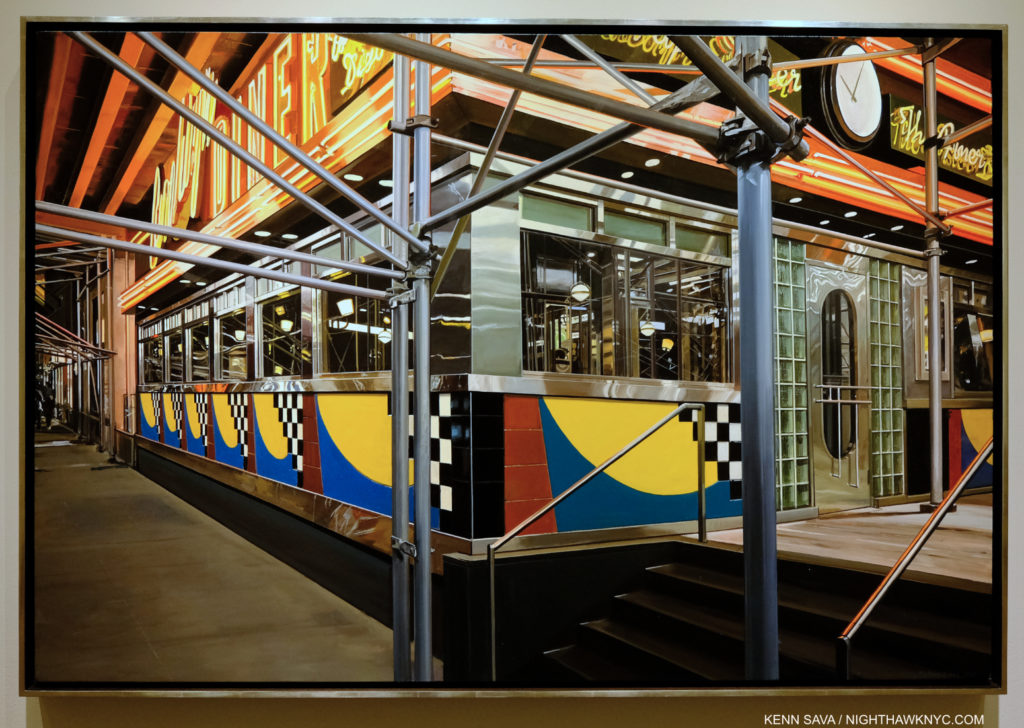
Brooklyn Diner, 2021(!), Oil on canvas, 37 x 55 1/4 inches. I was dumbstruck when I first saw this. I just hope I can still out of bed if/when I’m 89.
It’s a statement in more ways than one. First, it’s apparent even at a glance that he has lost none of his world-class technique! When I finally finished marveling at that, I began to ponder the unusual composition. I decided to take a look-see for myself. I jumped on the A Train and made a trip to the real Brooklyn Diner, which turned out to be a bit of an outlier on West 57th Street, to see what I could learn from the actual site.
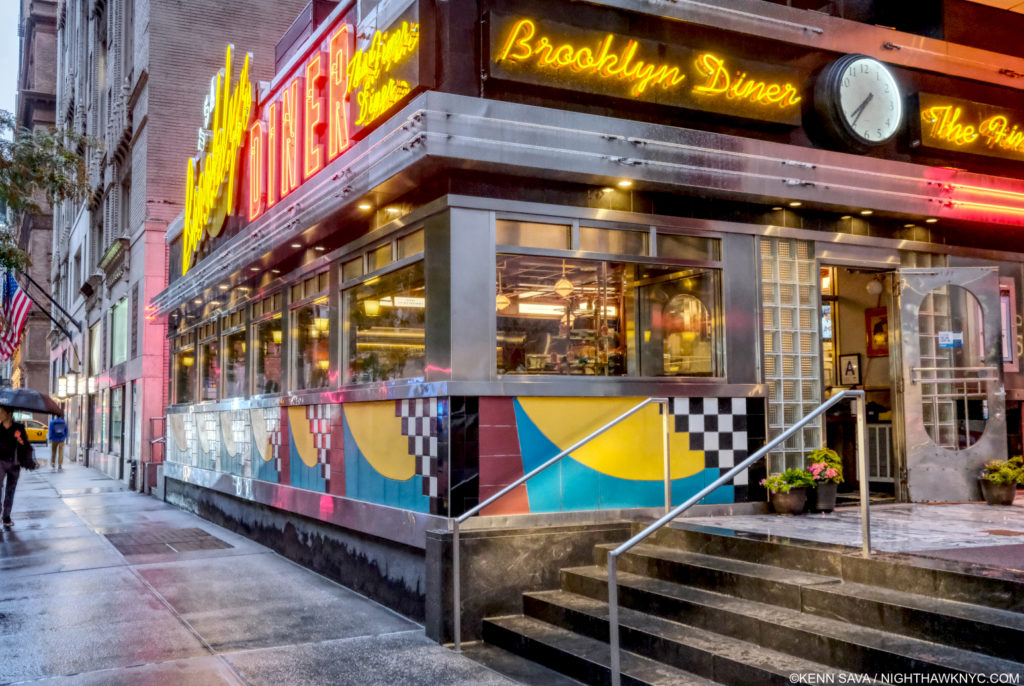
Brooklyn Diner seen from just behind the spot Richard Estes depicts. July 1, 2021. Notice how the “real” view lines up, or doesn’t line up, with the Painting. If I were standing closer, nearer that railing, as in the Painting, I wouldn’t be able to get the same view of the door, without a wider angle lens. The very wide 23mm lens I’m using here barely holds it, and I had to step back to get this! Suffice it to say I wasn’t able to take a Photo that exactly matches the Painting! Therefore, my Photo is not so-called “Paintingrealism,” to coin a box I hope no one uses. See important footnote-4.
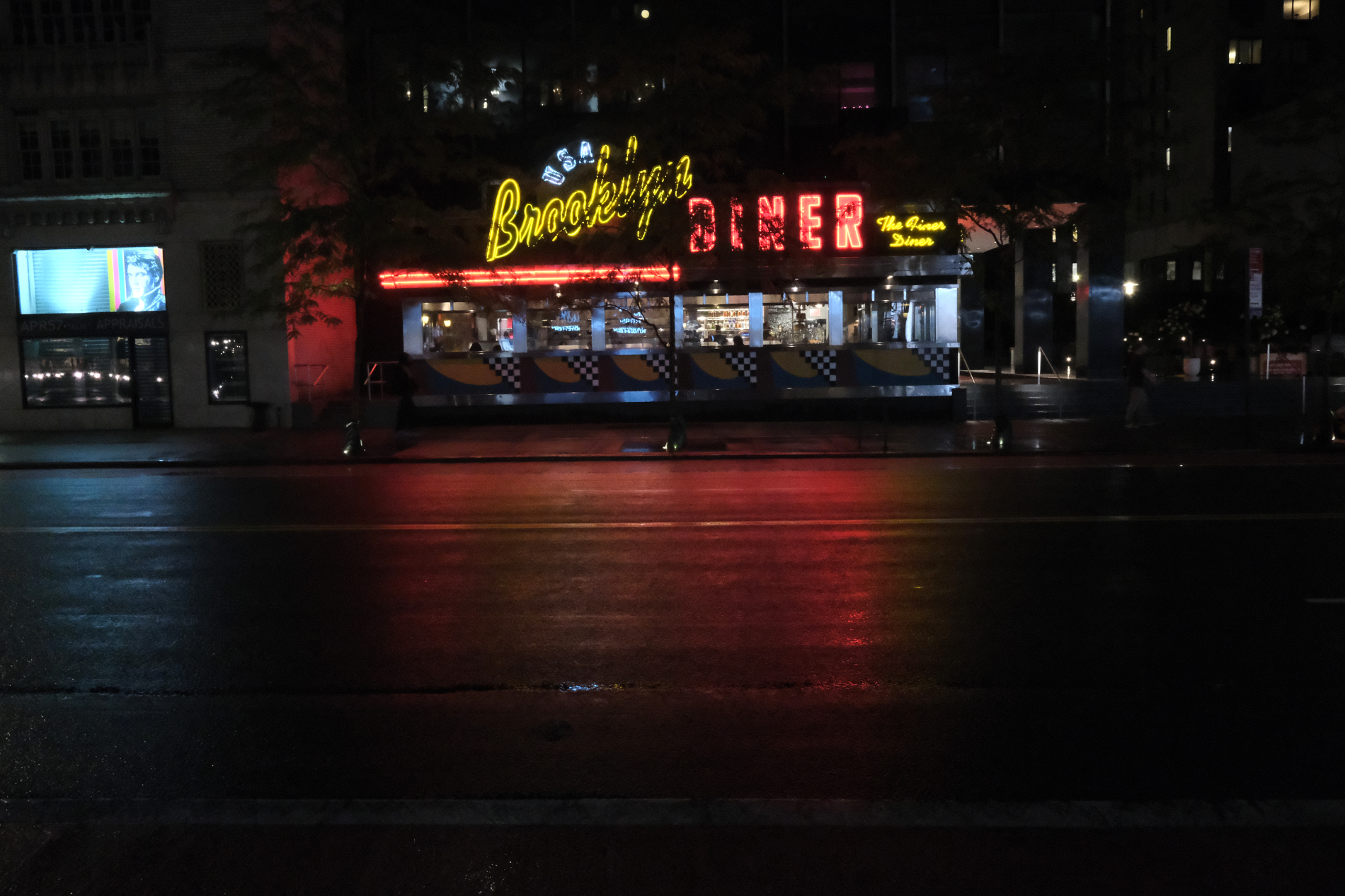
Booklyn Diner, July 1, 2021. The trees in front of it make its signage a bit less commanding, partially hiding it, like the scaffolding in the Painting does. The trees are our of the frame to the left in the Painting.
Scaffolding adds yet another layer to the countless layers many of his street scenes already had- exterior, reflections, interior, rear exterior, which often adds another level of complexity to the geometry of the whole thing, not to mention another layer of technical difficulty. It also adds mystery. It’s interesting to me that here, the top of the building is cut off. On the main sign to the left, you cannot read “Brooklyn,” and “Diner” is hard to see fully. Neither is legible on the sign to the right. In fact, if he didn’t name the Painting Brooklyn Diner, you wouldn’t know what this place was! This “selective editing” makes me feel that the facade, with its candy color, distantly Art Deco echo, is not the point of the piece, though it’s what catches the eye when you see either the Painting or the actual Diner on the street. The ways he has changed the scene are fascinating. Again, I wonder “Why?” The only conclusion I can make from this is that Mr. Estes is making the scene into what he wants to express.
The Diner sits, incongruously, a half a block, but worlds away from, the glitz, glamour and Artistry of, Carnegie Hall, and directly across the street from the legendary & historic Art Students League. This location is not far from Mr. Estes’s NYC apartment, and that fact has led him to render innumerable sites in this neighborhood in Paint over his long career.
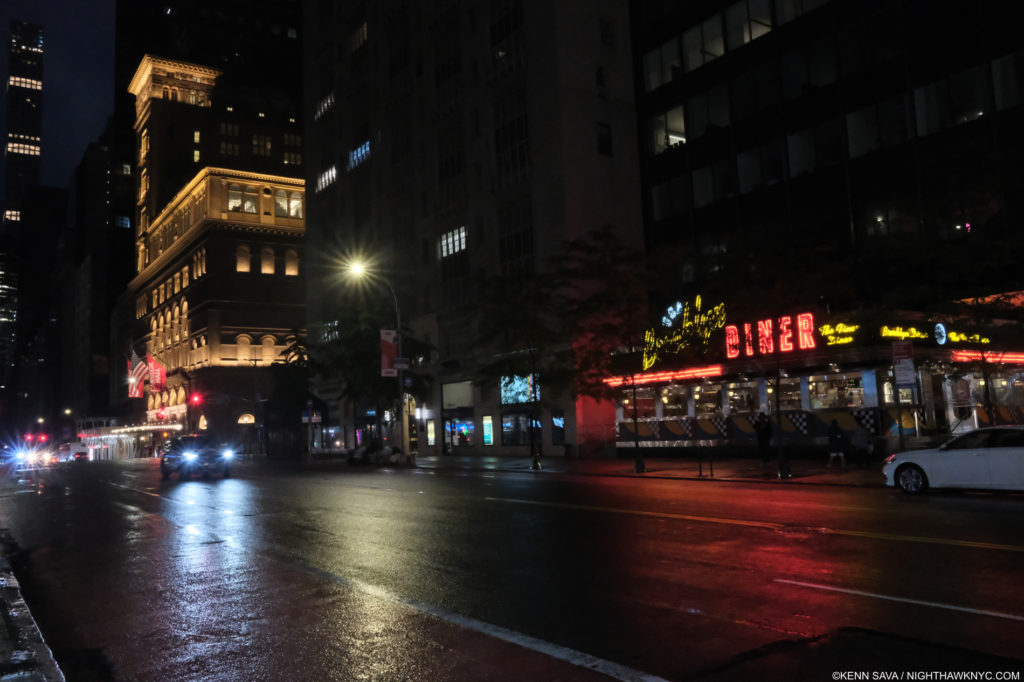
West 57th Street between 7th & 8th Avenues looking east. That’s Carnegie Hall, lit up left, Brooklyn Diner, behind the trees, right. My back is to the Art Students League. July, 2021.
In pondering why he chooses his subjects (which I still often do), I find something quite interesting about this location, and it’s shown in this photo- Richard Estes is a known lover of Classical Music. Yet, he has never Painted Carnegie Hall, the most famous Classical Music concert hall in the country and one of the most famous in the world! In Brooklyn Diner, a glow of a light may be seen at the far left nearer the top. That may be from Carnegie’s lights as shown here. That’s as close as he’s gotten! It begs the question “With all the buildings he’s depicted in the area, why hasn’t he Painted Carnegie Hall?” As for this subject, he has given un an unorthodox view of Brooklyn Diner, putting the focus of this work in an odd place. I imagine that if 100 other Painters chose to paint the Booklyn Diner, this is not the view we would get. From the street, the neon sign is the most striking thing about the Diner. In Mr. Estes’s Painting, the sign is cut and is far away from the center/focal point of the work. Instead, front and center are details of the scaffolding. What to make of this?
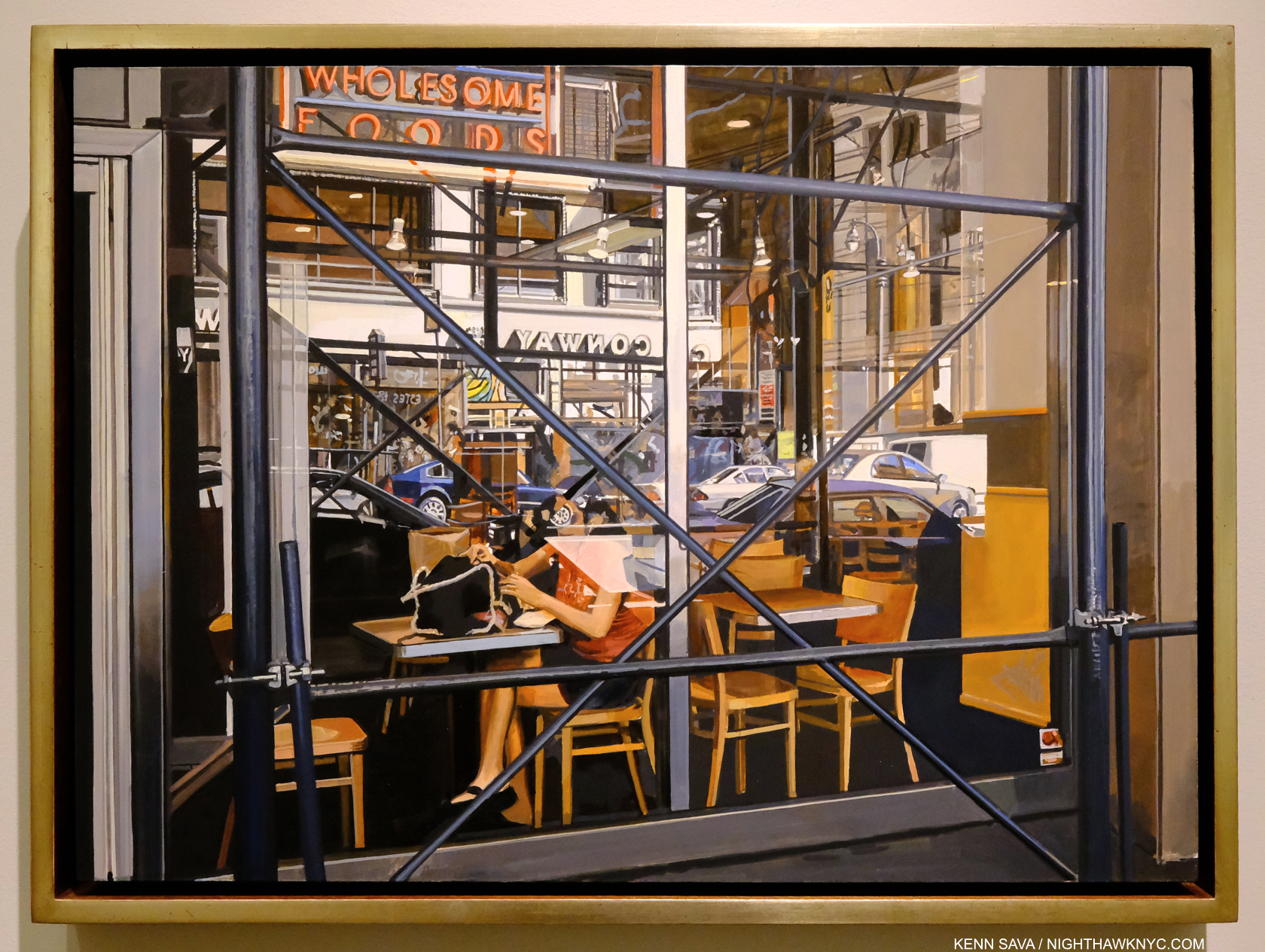
Wholesome Foods, #2, 2018, Oil on panel, 16 x 22 1/4 inches. Another of Richard Estes’s scaffolding Paintings, and another in which the scaffolding is font and center. The woman sitting behind it in the window is engulfed by the detritus of the modern world- glass, steel, wood, paper, cars, buildings, trees, and the materials she’s wearing. In this wonderful composition, which harkens back to, and updates, Edward Hopper’s similar scenes, and a store window reflection Photograph by Eugene Atget, which Mr. Estes has in his collection, she becomes just another element, or someone seen behind glass. I see this as a reminder of how the modern urban world forces its inhabitants to live, a scene that might look as odd to viewers in 300 years as Canaletto’s scenes of Venice look to us today. The geometry and depth of this piece is extraordinarily multi-dimensional, beautiful and ugly at the same time.
“I don’t enjoy looking at the things I paint, so why should you enjoy it?…I’m not trying to make propaganda for New York, or anything. I think I would tear down most of the places I paint.’” 5.
Those are not idle words. Richard Estes started out to be an Architect before he became an illustrator, and finally a Painter. When I looked at Corner Cafe, 2014-15, from the Painting New York City show, his most recent work at that time, I found that Mr. Estes had not eaten there. I don’t know, but I would imagine the same might be the case for the Brooklyn Diner. So much for a Painting of a place from a personal experience. If we remove personal experience from his choice of subject here (hypothetically) we’re left with something about this site inspiring the Artist creatively. It’s hard for me to look at Wholesome Foods, #2, or Brooklyn Diner, or any of the scaffolding Estes and not think he’s (symbolically) “X”ing out what we’re looking at, given what he said. In the case of Wholesome Foods, #2, possibly with multiple large, literal “Xs.” “… I would tear down most of the places I paint,” leaves it up to the viewer to decide which places he means. Maybe that’s why he hasn’t Painted Carnegie Hall?
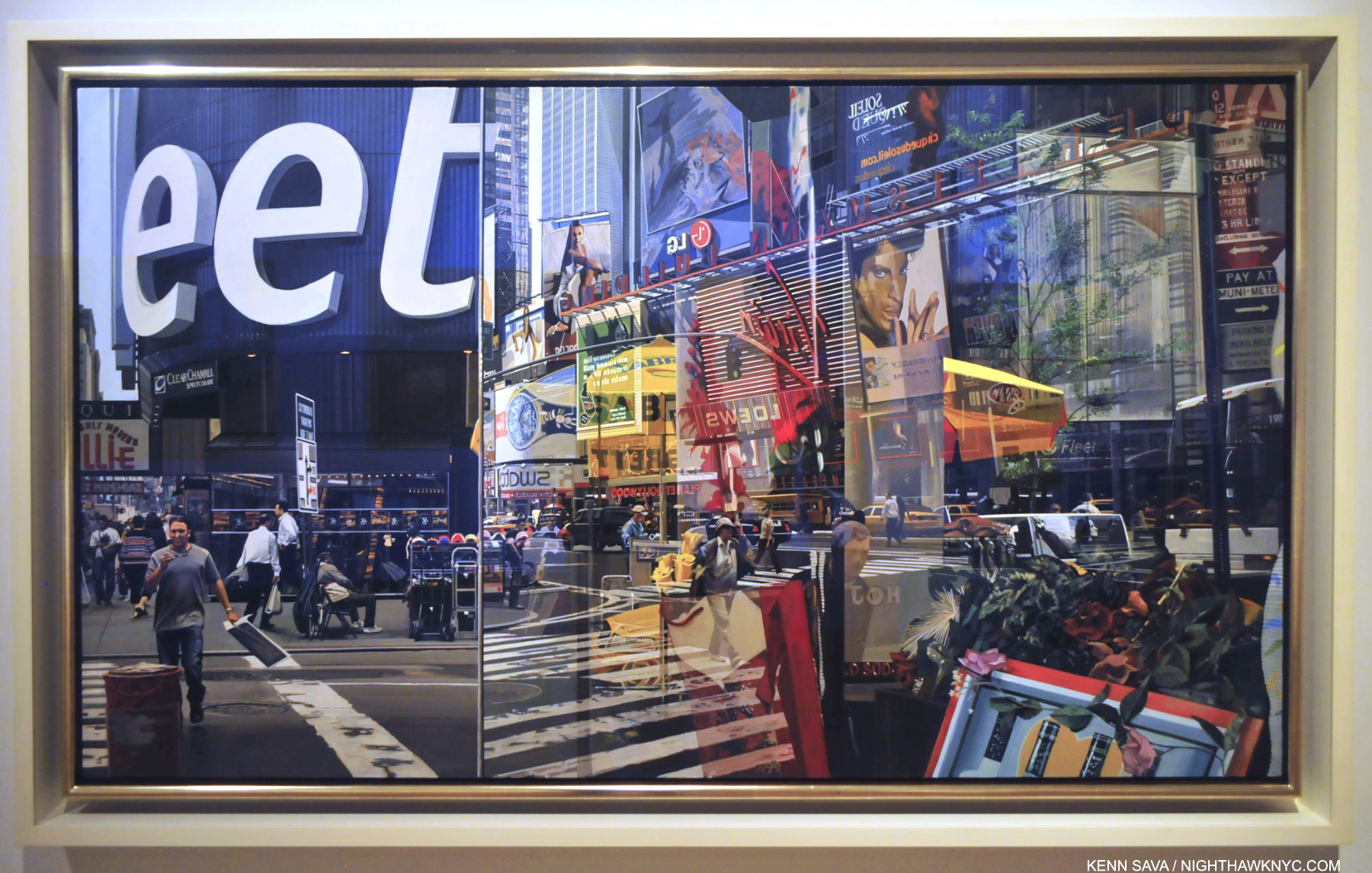
Times Square, 2004, Oil on canvas, 64 1/8 x 37 inches. Click on it to be fully engulfed. Seen at his 2015 Museum of Art & Design show, this may be the most technically astounding Painting I’ve ever seen, along with any Painting by Jan van Eyck. Having stood on this spot before, during and after 2004, I can certainly verify the overwhelming visual noise that still is Times Square, something that has never been more faithfully realized than it is here. Like most New Yorkers, including this one, maybe Richard Estes would like to see it torn down? Still, the Painting would live on as a reminder of how we actually lived here in 2004. “Progress” since the time of Canaletto (1697-1768)? It could also be read as a comment along those lines.
Overall, I see Richard Estes as a direct successor to the Artists he has named as influences- Canaletto, his nephew Bellotto, Thomas Cole, Frederic Church and Thomas Eakins. All of these Artists depicted the world around them without an ostensible “message,” though Thomas Cole also created the series The Course of Empire, in 1833-6, which I looked at here, that do appear to have a message. After the fact, Conservation has come to be seen as one interpretation of Cole, Church and their contemporaries, who were lumped in the Hudson River School box by someone else. That aside, I look at Richard Estes’s work the same way I look at any of theirs.
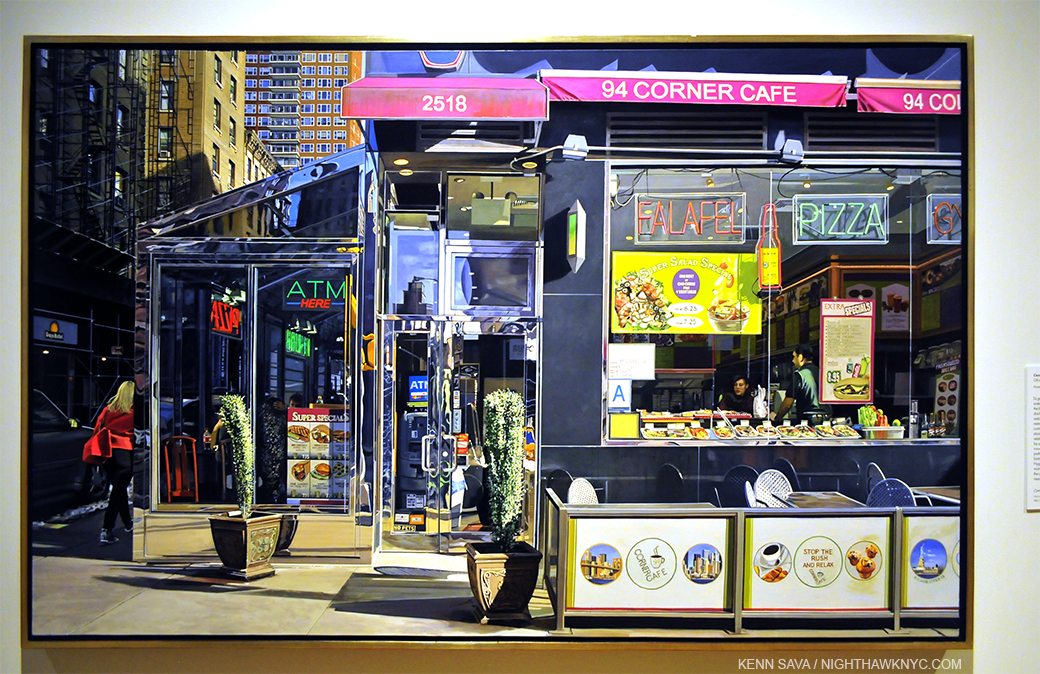
Richard Estes, Corner Cafe, 2014-15, the newest work shown in his Museum of Art & Design Painting New York City show, and seen there in 2015. Oil on Canvas. The Artist was only 83 when he Painted this. I visited the actual Corner Cafe shortly after seeing it. Interestingly, due to a large phone booth in the way, I again had great difficulty trying to duplicate the view seen in the Painting in a Photo!
I get similar feelings looking at some of Mr. Estes’s Urban Landscapes, like Wholesome Foods, #2, Corner Cafe and Horn & Hardart, 1967 that I get looking at Edward Hopper’s urban scenes, including Nighthawks, as I said in my 2016 look at Mr. Estes’s Corner Cafe. This is incredibly rare. Though countless other Artists have tried to emulate Hopper, (which I am not saying Mr. Estes is) I can’t say I’ve felt that from any of them. Seven years after I first saw it, I still get that feeling when I look at Corner Cafe, which I now feel is a masterpiece.
When taken as a whole, the 55 year & counting body of Paintings & Prints he’s created, some interesting things become apparent. Looking back over more than a half century, Richard Estes’s Paintings show us two worlds.
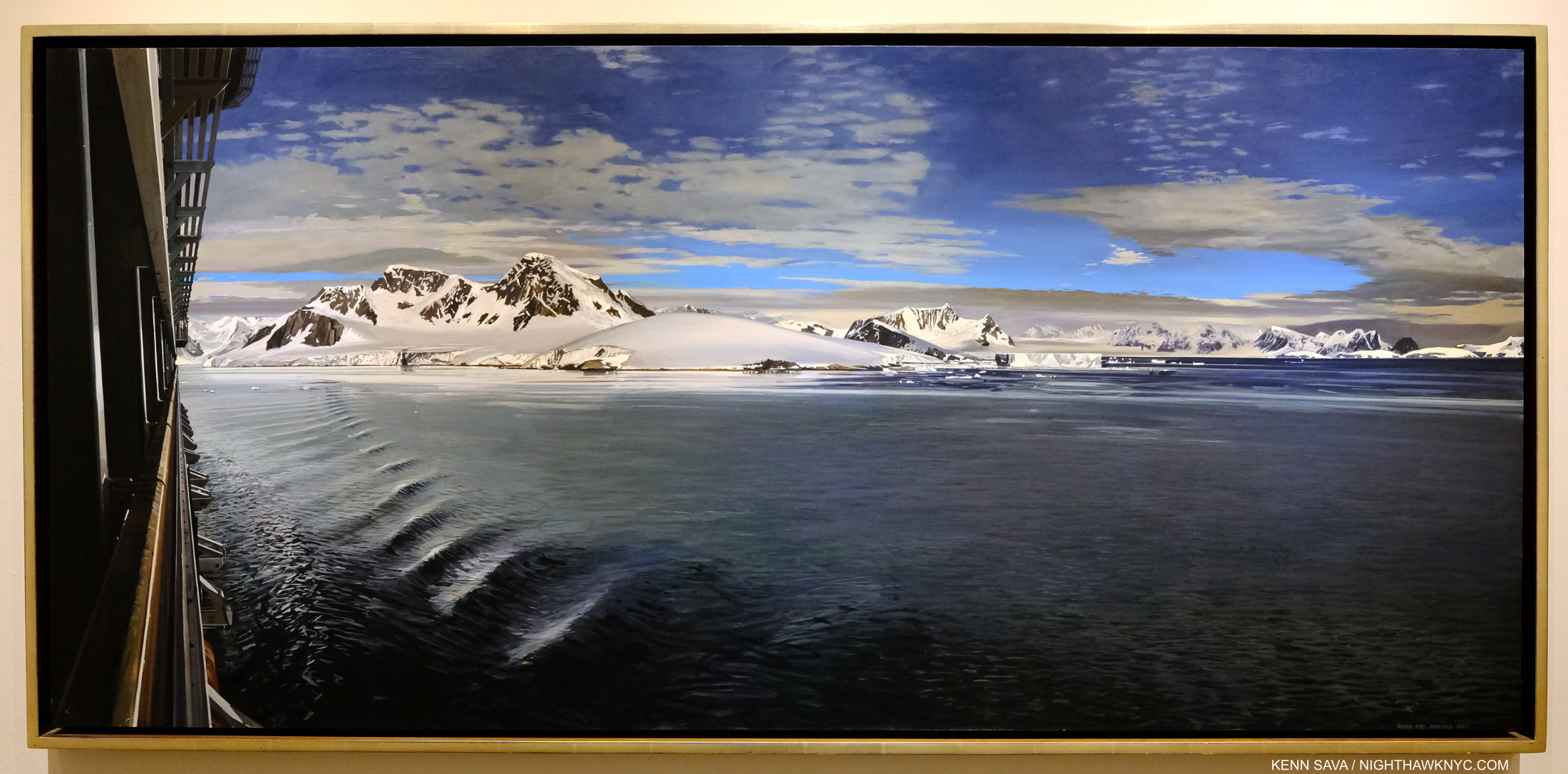
Antarctica II, 2007. Oil on panel, 26 3/8 x 57 inches. Canaletto (1697-1768) lived 300 years ago. In 300 years, will people look at this as something they can relate to in their world, or something from the lost past?
First, the world he lives in and around in NYC, and to a lesser extent, the other cities he has visited & Painted around the world- i.e. his so-called Urban Landscapes6. The second is the world he lives in and around his second home in Maine, and the natural world he has visited on his many trips to other lands. Both groups can be summarized thus- 1) Works depicting the world built by man on the one hand, and, 2) Works depicting the unbuilt, natural world on the other. There is obvious intention in this. Mr. Estes has chosen each and every subject he has Painted. Outside of a handful of Portraits (some commissions, some gifts), I’m leaving nothing out of his oeuvre in saying this. It’s incredibly rare in Art history to find ANY Artist who’s entire body of work fits so neatly into two categories!
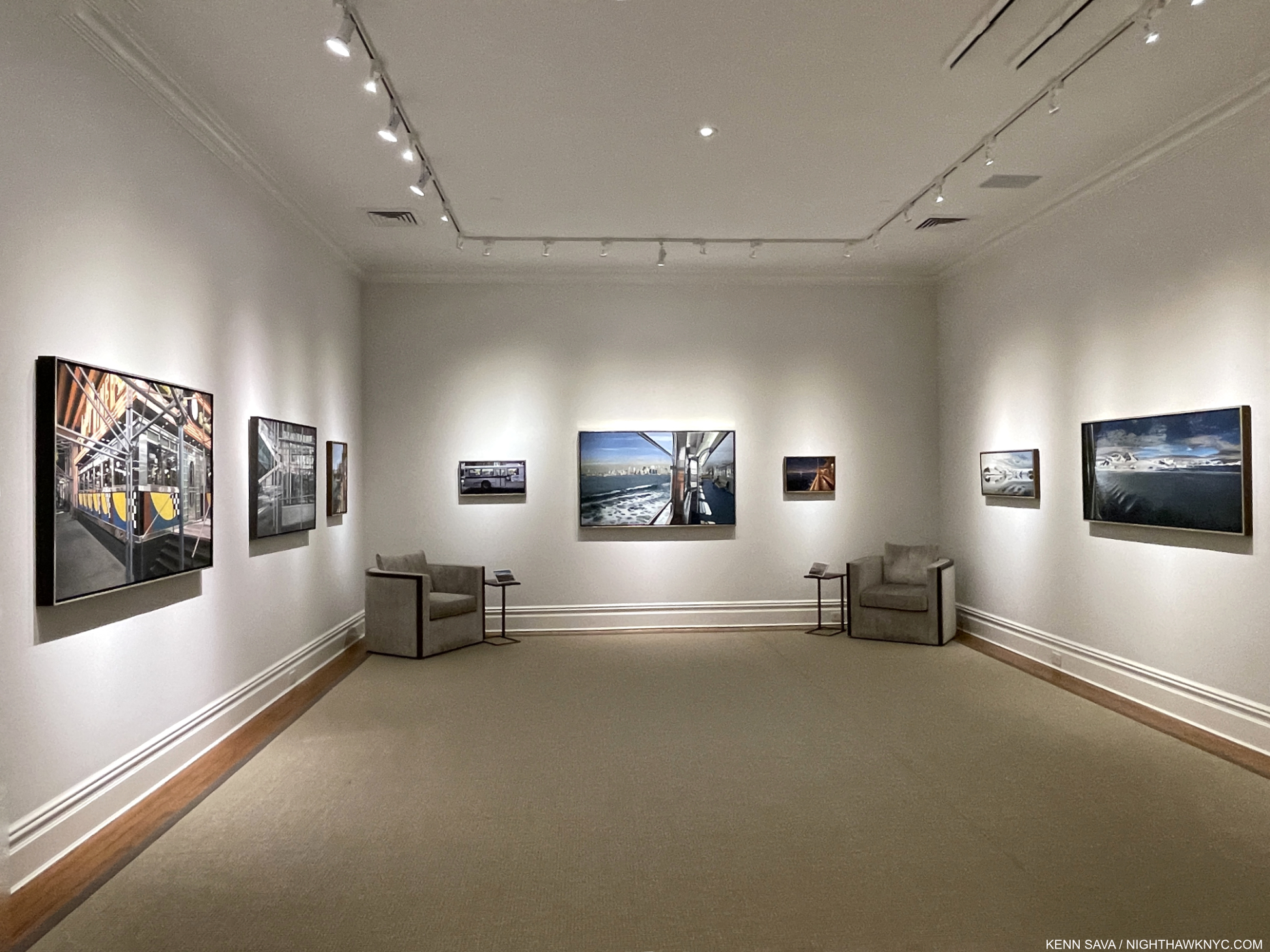
Voyages, installation view of the second gallery. NYC Urban Landscapes on the left wall, Antarctica Paintings on the right, one of each to the far left and far fright is cut off.
Seeing some of each of the categories on view face to face in Voyages brought this duality home for me in a convincing fashion. On one wall in the second gallery, left above, a rotating selection of Paintings of Manhattan faced a selection of Paintings of Antarctica on the opposite wall, right. For me, this summed up his career to date in a nutshell. The city scapes show the city (NYC, London, Paris, Madrid, Tokyo, etc) on typical days, much like the Venice Canaletto and Bellotto show us. Mr. Estes’s Paintings of the natural world seem to follow in the long tradition of landscapes by American Artists, including Thomas Cole, Church, et al, as well as Edward Hopper’s views of Maine (among many other Artists who have preceded Mr. Estes and lived & worked in Maine. Thomas Cole also Painted Mount Desert, Maine, the subject of a number of Mr. Estes’s Paintings).
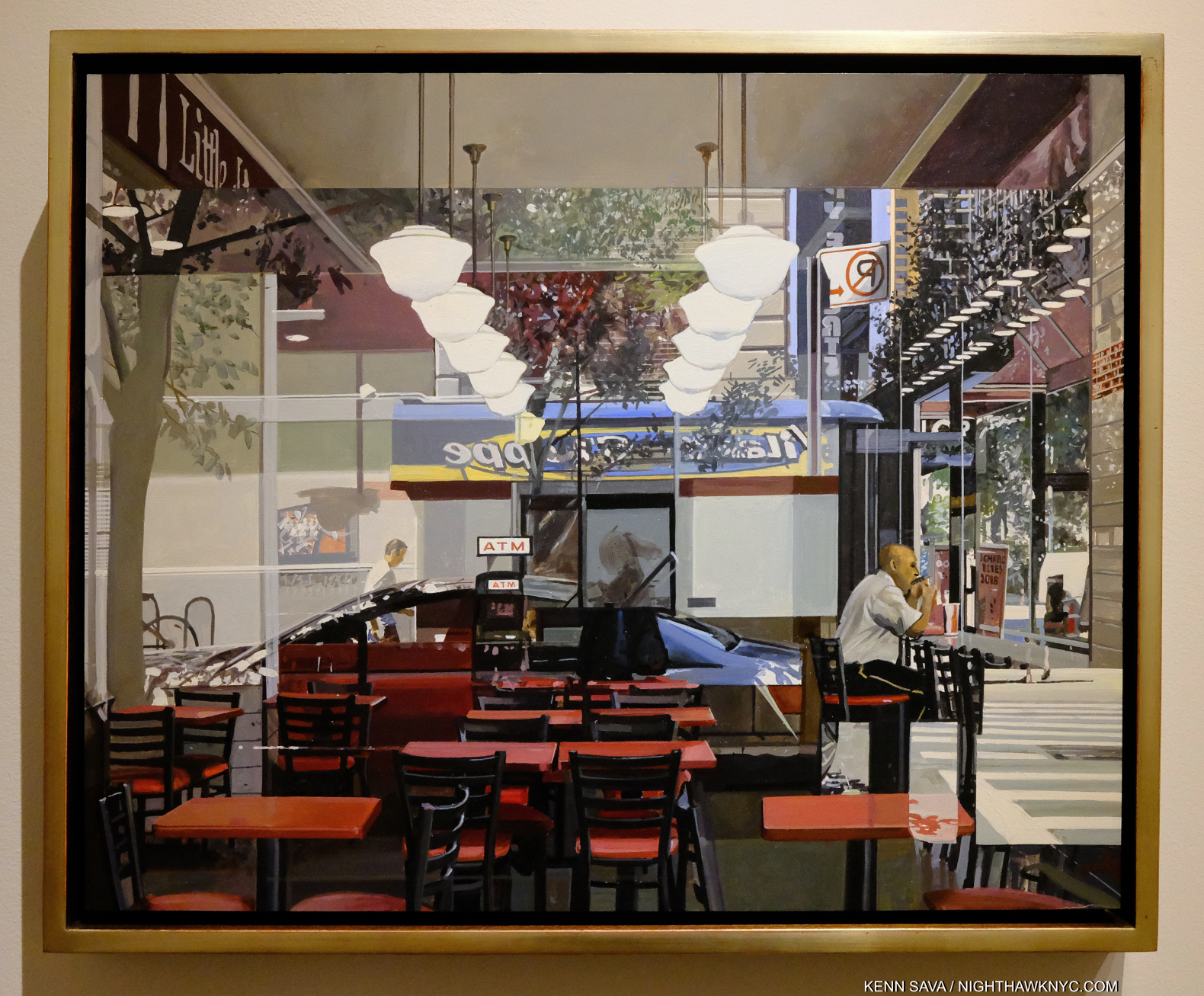
ATM, 2018, Oil on panel, 16 x 20 inches. In this marvelous Urban Landscape, it seems to me that only the three empty chairs in the mid foreground are in sharp focus, doing something Mr. Estes does in many of his pieces- de-emphasizing human subjects to avoid the narrative as I’ve heard him say- even when there are people present in the Painting. No Painter known to me Paints the modern city like Richard Estes. This Painting is hanging to the far left, just out of the frame in the prior picture.
His Paintings of the man-made world (i.e. his Urban Landscapes) might well be called New Topographic if they were Photographs because it seems to me they see the world through the same lens as the legendary New Topographics Photography show at the Kodak Museum in Rochester in 1975, which focused on the “Man-Altered Landscape,” the show’s subtitle. Mr. Estes’s NYC Paintings predate this show by 7 or 8 years, though the Photographers included in it were working at the same time he was. I have no information that either Mr. Estes knew these Photographers or their work, then or now.
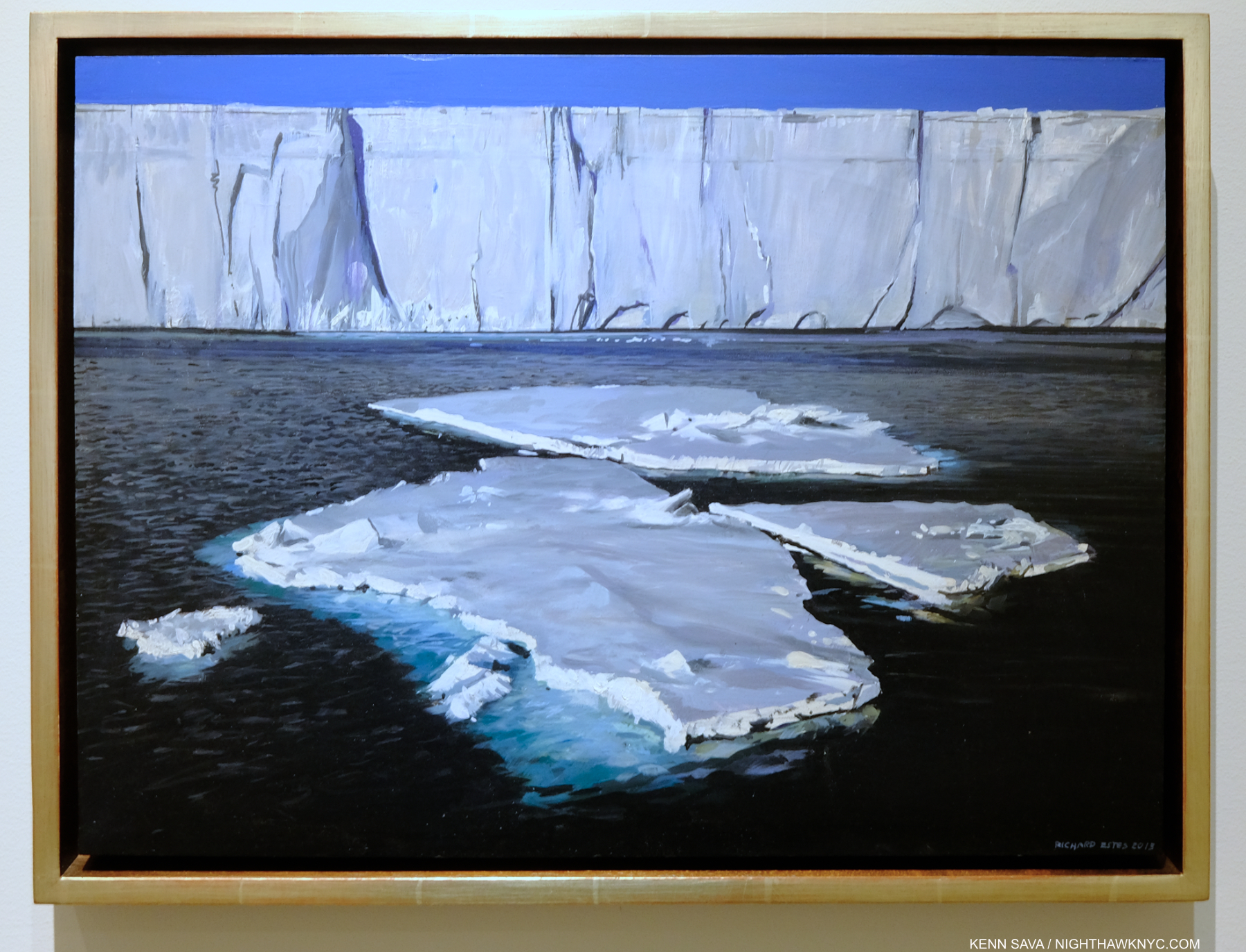
Antarctica I, 2013, Oil on panel, 14 3/4 x 20 inches. Another Antarctica Painting brings me back to what I said I saw in Antarctica II up top.
“Richard Estes avows that his realism has no hidden meanings, special messages, or stories to tell. Political positions and posturing about the human condition are alien to his art,7.”
So, how to reconcile what I said about in the beginning of this piece about Antarctica II with this? Mr. Sims’s words are not an actual quote, and so are less than ideal. As I said, Richard Estes has chosen to show us each and every one of these sites, so there is obvious intention in that. The two facing walls I showed in Voyages were in his show, so there is intention in that, too. Beyond this, he is directly quoted (shown earlier) saying that he would like to see many of the sites he has Painted torn down. Is he fearful of the loss of much of the natural world during his lifetime? He is known to be actively involved in conservation efforts, particularly in Maine. Is he recording both the man-made and the state of the natural world for future generations? Given the time he has spent studying Canaletto and Thomas Cole, even visiting sites they Painted, I would say it is possible. Yet, it must be admitted that Mr. Estes may simply be an observant onlooker at the ever-changing world he’s seen first hand near and far, then creating Paintings that express what he’s experienced. As I’ve demonstrated, these are NOT verbatim depictions. He’s an Artist, not a replicating machine, as I showed in Part 1. Regardless of the nebulous statement from Mr. Sims above, Mr. Estes intends exactly what he shows us, aided by a technique that is the equal of that only a very few Artists in Art history have had to render his intentions as clearly as is humanly possible. He also is well aware that every viewer will see in his work what they will, as he sees, has seen, and is himself influenced by, those he admires who have come before him.
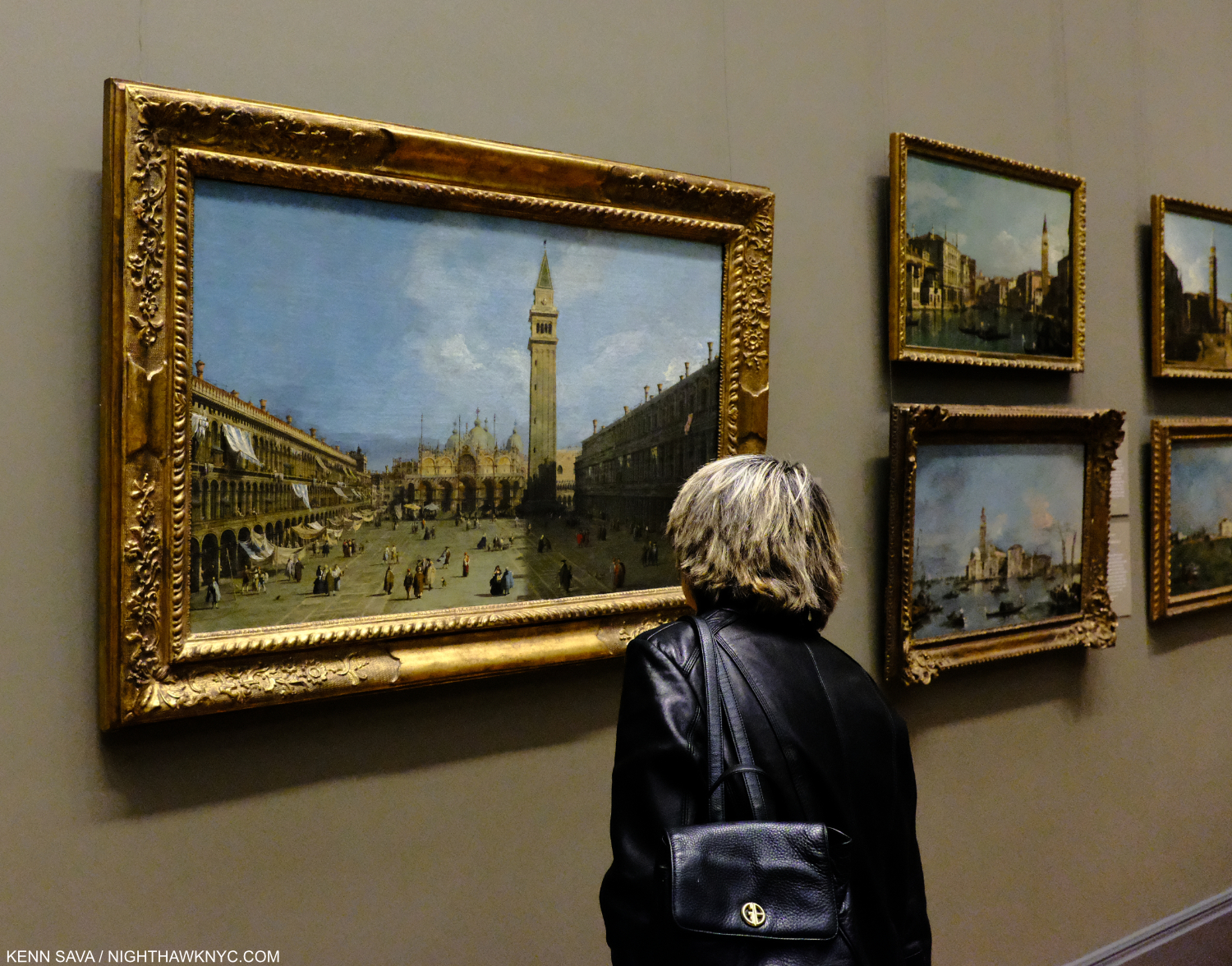
What will our world look like to people 300 years from now? A viewer looks at Canalellto’s Piazza San Marco, 1720s, in 2019, almost exactly 300 years after it was Painted, at The Met. While I have no doubt that Richard Estes, himself, has stood in this spot any number of times, this isn’t just any viewer. This is Lana Hattan, who pushed me to start NighthawkNYC in 2015. Seen here on one of the last times I’ve seen her, December 14, 2019. If you find this site worthwhile, you owe her your thanks. Without her push, it wouldn’t be here.
Richard Estes’s Paintings speak for themselves, and they should be allowed to- beyond boxes or other limitations. The Artist doesn’t need to stand up and say, “This Painting is about _____.” They are what they are. Look for yourself at them and see what they say to you.
“I see what I see,” as Frank Stella says. For me, Richard Estes has Painted the most compelling record of the New York City of my lifetime in it. He has also created a beautiful record of much of what’s left of the natural world. It’s a record of the world in his time- what’s been built by man, and and what’s left of the natural world, rendered through the hands and mind of an Artist. I see a “dialogue” going on when I look at both bodies of his work. In the end, intentionally or not, his work shows the condition of the world in his (and our) time. Including (again, intentionally or not), depictions of a number of key issues modern man faces and has created.
I can only wonder what viewers in hundreds of years will make of what he shows us. I have a sneaking feeling that Richard Estes has thought a lot about this, too.
-The 3rd, and final, Part of this series, “Richard Estes: Two Manifestos” is below this one, or here.
-Part 1 is here.
-My piece on Richard Estes’s Corner Cafe, 2013, may be seen here.
–My look at the 2015 Richard Estes: Painting New York City show at the Museum of Art & Design may be seen here.
-My piece “Death to Boxes!” is here.
*-Soundtrack for this Post is “Once in a Lifetime,” by David Byrne & Talking Heads, from Remain in Light, 1980, and performed here In Los Angeles in 1983, extracted from the Film Stop Making Sense–
NighthawkNYC.com has been entirely self-funded and ad-free for over 6 years, during which over 250 full length pieces have been published. As I face high expenses to keep it going, if you’ve found it worthwhile, please donate to keep it up & ad-free below. Thank you!
Written & photographed by Kenn Sava for nighthawknyc.com unless otherwise credited.
To send comments, thoughts, feedback or propositions click here.
Click the white box on the upper right for the archives or to search them.
For “short takes” and additional pictures, follow @nighthawk_nyc on Instagram.
Subscribe to be notified of new Posts below. Your information will be used for no other purpose.
- From Bus with Reflection of the Flatiron Building, 1967, shown in Part 1 ↩
- P.1. Wait. Shouldn’t it read “Richard Estes avows that his Art has no…?” Substituting the “realism” box for the “photorealism” box isn’t any better, in my view. Richard Estes is a Painter- with no prefixes, in my book, the point of Part 1 of this series. Death to boxes! ↩
- Urban Landscapes is the title of 3 series of Screenprints the Artist has created. I showed one from my collection in Part 1. It was also the title of a show of Mr. Estes’s work in 1978 at the Museum of Fine Arts, Boston. ↩
- After I finished this Part, I saw the book Richard Estes: Voyages. In it, Mr. Estes says that he now destroys his source Photographs because he doesn’t want them compared to the Painting. I understand and respect his decision. I saw a few of his source Photos in the 2015 M.A.D. Museum show and showed a few in my piece on Corner Cafe. To honor his feelings, I have revised that piece and removed them. I am publishing these because- a) they are not his source Photos, and b) because I feel they highlight the differences between actual locations and his Paintings, showing the lie to some of the hype around Richard Estes’s work, as I outlined in Part 1. It must be noted, and I think it is very interesting, that I was unable to replicate the view seen in both Brooklyn Diner, 2021, and Corner Cafe, 2014-15 when I visited both ↩
- ibid, p.1 ↩
- I’m including his so-called “Still Life” Paintings in this since they depict objects seen in windows or on shelves and are not studio setups. ↩
- In a conversation with Patterson Sims per Patterson Sims, Richard Estes’ Realism, P.1 ↩
